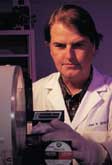 Teaming
up to fight cancer Turteltaub is also partnering with deVere White to test DNA adducts in prostate cancer tissue. Volunteer patients will swallow capsules containing the equivalent of two weeks' worth of heterocyclic amine before prostate cancer surgery. After surgeons have removed the tissue, Lawrence Livermore researchers will analyze it for DNA adducts. "Cancer is a continuum of events that begins with minor changes to the cells' DNA," he said. "We're looking at changes in DNA very early, long before cancer develops." Such precision is possible because of the lab's $7 million accelerator mass spectrometer. The technology was originally developed to measure the age of archaeological artifacts by counting the amount of a particular carbon isotope in a sample. The instrument combines a linear accelerator, an ionizer and large magnets to analyze and count atoms. It's so sensitive that it can detect one adduct out of a sample of 10 million DNA bases. The same sensitivity that allows accelerator mass spectrometry to find DNA adducts can also be used to analyze how well drugs are absorbed in the body. Oncologists typically prescribe chemotherapy based on a patients' weight, age, sex and liver function. With accelerator mass spectrometry, doctors could direct dosages based on a patient's individual metabolism, lessening side effects and improving drug effectiveness. Researchers in the cancer center's Division of Hematology/Oncology are in discussions with Lawrence Livermore to design human protocols.
Home |
Table of Contents |
To our Readers |
Building on Basics UC Davis Health System | © 2000, 2001, 2002 UC Regents. All rights reserved. |
John Boone, a professor of radiology at UC Davis Medical Center, is developing a CT scanner for mice to be used in animal-model studies of disease. The new tool will reduce the number of mice needed for a project while giving researchers better quantitative information. |

